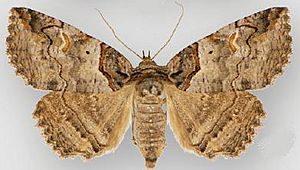Bold-based zale facts for kids
Quick facts for kids Bold-based zale |
|
|---|---|
 |
|
| Scientific classification | |
| Kingdom: | |
| Phylum: | |
| Class: | |
| Order: | |
| Family: | |
| Genus: |
Zale
|
| Species: |
Z. lunifera
|
| Binomial name | |
| Zale lunifera (Hübner, 1818)
|
|
| Synonyms | |
|
|
The bold-based zale (scientific name: Zale lunifera) is a type of moth. It also has other common names like the pine barrens zale. This moth belongs to a large family called Noctuidae, which includes many different kinds of moths. A scientist named Jacob Hübner first described this species in 1818.
Contents
Meet the Bold-Based Zale Moth!
These moths are quite interesting creatures. They are known for their unique patterns. Moths are insects, just like butterflies, but they are usually active at night.
What Does It Look Like?
The bold-based zale moth has a wingspan of about 37 to 45 millimeters. That's roughly the length of a few paperclips! Adult moths can be seen flying around during two main periods: from April to May and again from July to August. This means they have two generations of moths each year.
Where Does It Live?
You can mostly find the bold-based zale moth in the eastern and southern parts of the United States. They live east and south of the Appalachian Mountains. Their range stretches from southern Maine all the way down to Florida and Mississippi.
They prefer certain types of places to live. For example, in southeastern Georgia, they like open forests with sandy soil and lots of pine and oak trees. They are not usually found in places like southeastern Virginia or South Carolina, but they might be there. It's unlikely to find them in Maryland and Delaware because those states don't have the right kind of habitat for them.
What Do Young Moths Eat?
Like many insects, moths go through different life stages. The young moths are called larvae, or caterpillars. These caterpillars love to eat leaves from different kinds of oak trees. They especially enjoy munching on Quercus ilicifolia and other types of scrub oak. Scrub oaks are usually smaller, bushier oak trees.

